Team Personality Composition Influences Team Performance
VerifiedAdded on 2019/09/23
|12
|2892
|441
Report
AI Summary
This assignment discusses the importance of power dynamics within teams for their overall effectiveness. It highlights the three key factors that influence team performance: collective cognitive ability, work groups and teams, and team power dispersion. The analysis emphasizes the need to consider both the level and dispersion of power held by team members, as well as the variety of power sources they draw upon. Furthermore, it underscores the crucial role of work groups and teams in an organization's success or failure.
Contribute Materials
Your contribution can guide someone’s learning journey. Share your
documents today.
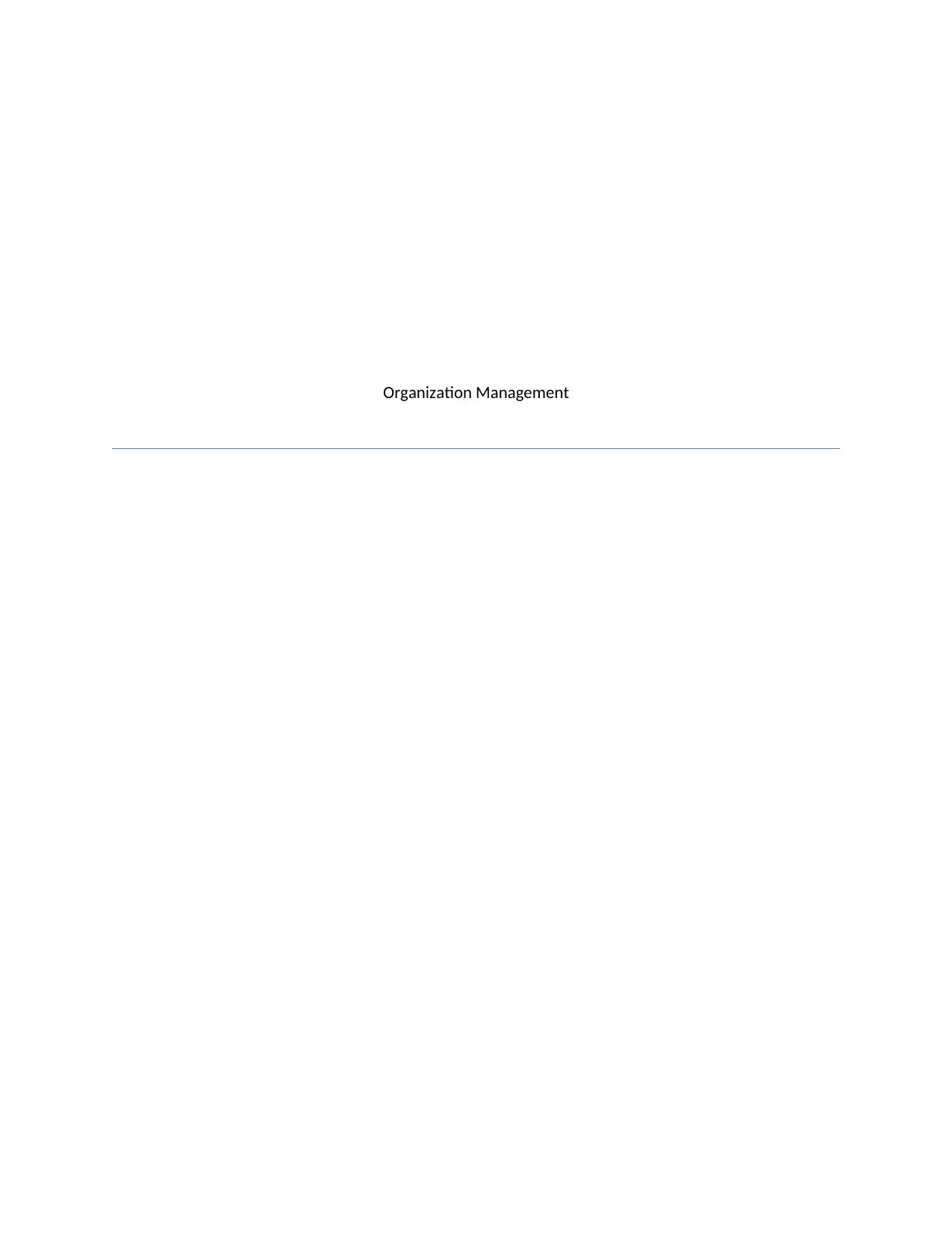
Organization Management
Secure Best Marks with AI Grader
Need help grading? Try our AI Grader for instant feedback on your assignments.
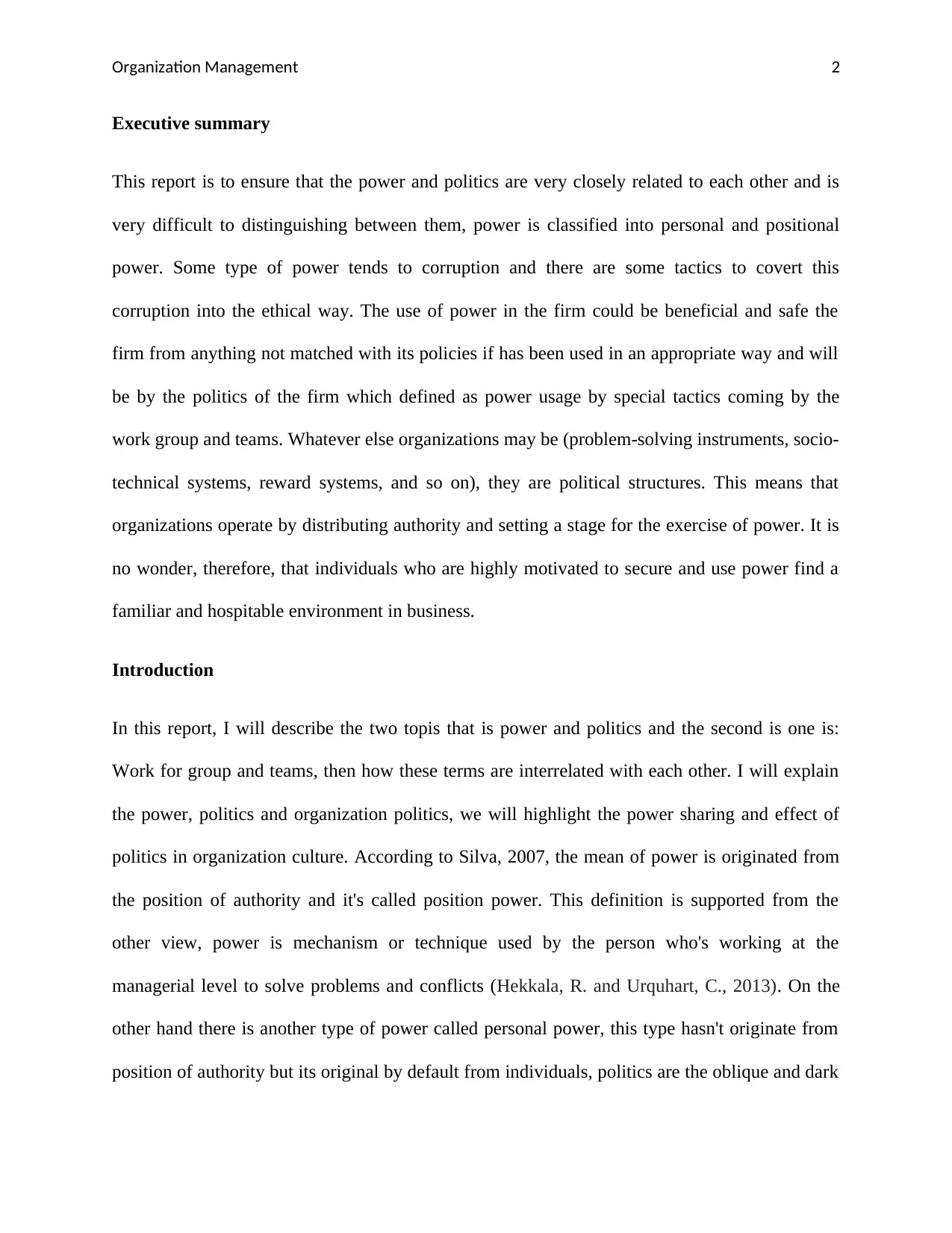
Organization Management 2
Executive summary
This report is to ensure that the power and politics are very closely related to each other and is
very difficult to distinguishing between them, power is classified into personal and positional
power. Some type of power tends to corruption and there are some tactics to covert this
corruption into the ethical way. The use of power in the firm could be beneficial and safe the
firm from anything not matched with its policies if has been used in an appropriate way and will
be by the politics of the firm which defined as power usage by special tactics coming by the
work group and teams. Whatever else organizations may be (problem-solving instruments, socio-
technical systems, reward systems, and so on), they are political structures. This means that
organizations operate by distributing authority and setting a stage for the exercise of power. It is
no wonder, therefore, that individuals who are highly motivated to secure and use power find a
familiar and hospitable environment in business.
Introduction
In this report, I will describe the two topis that is power and politics and the second is one is:
Work for group and teams, then how these terms are interrelated with each other. I will explain
the power, politics and organization politics, we will highlight the power sharing and effect of
politics in organization culture. According to Silva, 2007, the mean of power is originated from
the position of authority and it's called position power. This definition is supported from the
other view, power is mechanism or technique used by the person who's working at the
managerial level to solve problems and conflicts (Hekkala, R. and Urquhart, C., 2013). On the
other hand there is another type of power called personal power, this type hasn't originate from
position of authority but its original by default from individuals, politics are the oblique and dark
Executive summary
This report is to ensure that the power and politics are very closely related to each other and is
very difficult to distinguishing between them, power is classified into personal and positional
power. Some type of power tends to corruption and there are some tactics to covert this
corruption into the ethical way. The use of power in the firm could be beneficial and safe the
firm from anything not matched with its policies if has been used in an appropriate way and will
be by the politics of the firm which defined as power usage by special tactics coming by the
work group and teams. Whatever else organizations may be (problem-solving instruments, socio-
technical systems, reward systems, and so on), they are political structures. This means that
organizations operate by distributing authority and setting a stage for the exercise of power. It is
no wonder, therefore, that individuals who are highly motivated to secure and use power find a
familiar and hospitable environment in business.
Introduction
In this report, I will describe the two topis that is power and politics and the second is one is:
Work for group and teams, then how these terms are interrelated with each other. I will explain
the power, politics and organization politics, we will highlight the power sharing and effect of
politics in organization culture. According to Silva, 2007, the mean of power is originated from
the position of authority and it's called position power. This definition is supported from the
other view, power is mechanism or technique used by the person who's working at the
managerial level to solve problems and conflicts (Hekkala, R. and Urquhart, C., 2013). On the
other hand there is another type of power called personal power, this type hasn't originate from
position of authority but its original by default from individuals, politics are the oblique and dark

Organization Management 3
side of power and type of corruption and describing the political tactics as "hateful", another
description of politicized decision making is supported in book on the "shadow side" of
management its destiny to the dark side.
On the other hand, work groups and loans: we will illustrate the definition and differences
between individuals, groups and work groups, I will focus on the factors that factors that affect
team effectiveness with effective and real models from an organisation I observed in case
studies.
Analysis
All sorts of power even absolute power tend to corruption. So, how to use power ethically
understanding and knowing your goals and your organization objectives and target. Examine and
diagnose which employee inside or outside organization can affect and achieve your goals plan.
Getting information about each employee you manage and knowing the strengths and
weaknesses of each employee (Buchanan, D. and Badham, R., 2008). It should also know the
strength and weakness points of the person, knowing which strategy can affect your employees
by way of exercising power examine and diagnose the feel and action of your employees after
your tasks or actions. However, the concept of power tends corruption has been criticized.
Argued that power affects positively in organization sustainability, power doesn't affect
employees negatively or make them frustrated. To prove this concept, assume that managers who
have a high level of power can work as supporter and assistant to their subordinate and vise-
versa.
Power sharing in organization culture
side of power and type of corruption and describing the political tactics as "hateful", another
description of politicized decision making is supported in book on the "shadow side" of
management its destiny to the dark side.
On the other hand, work groups and loans: we will illustrate the definition and differences
between individuals, groups and work groups, I will focus on the factors that factors that affect
team effectiveness with effective and real models from an organisation I observed in case
studies.
Analysis
All sorts of power even absolute power tend to corruption. So, how to use power ethically
understanding and knowing your goals and your organization objectives and target. Examine and
diagnose which employee inside or outside organization can affect and achieve your goals plan.
Getting information about each employee you manage and knowing the strengths and
weaknesses of each employee (Buchanan, D. and Badham, R., 2008). It should also know the
strength and weakness points of the person, knowing which strategy can affect your employees
by way of exercising power examine and diagnose the feel and action of your employees after
your tasks or actions. However, the concept of power tends corruption has been criticized.
Argued that power affects positively in organization sustainability, power doesn't affect
employees negatively or make them frustrated. To prove this concept, assume that managers who
have a high level of power can work as supporter and assistant to their subordinate and vise-
versa.
Power sharing in organization culture
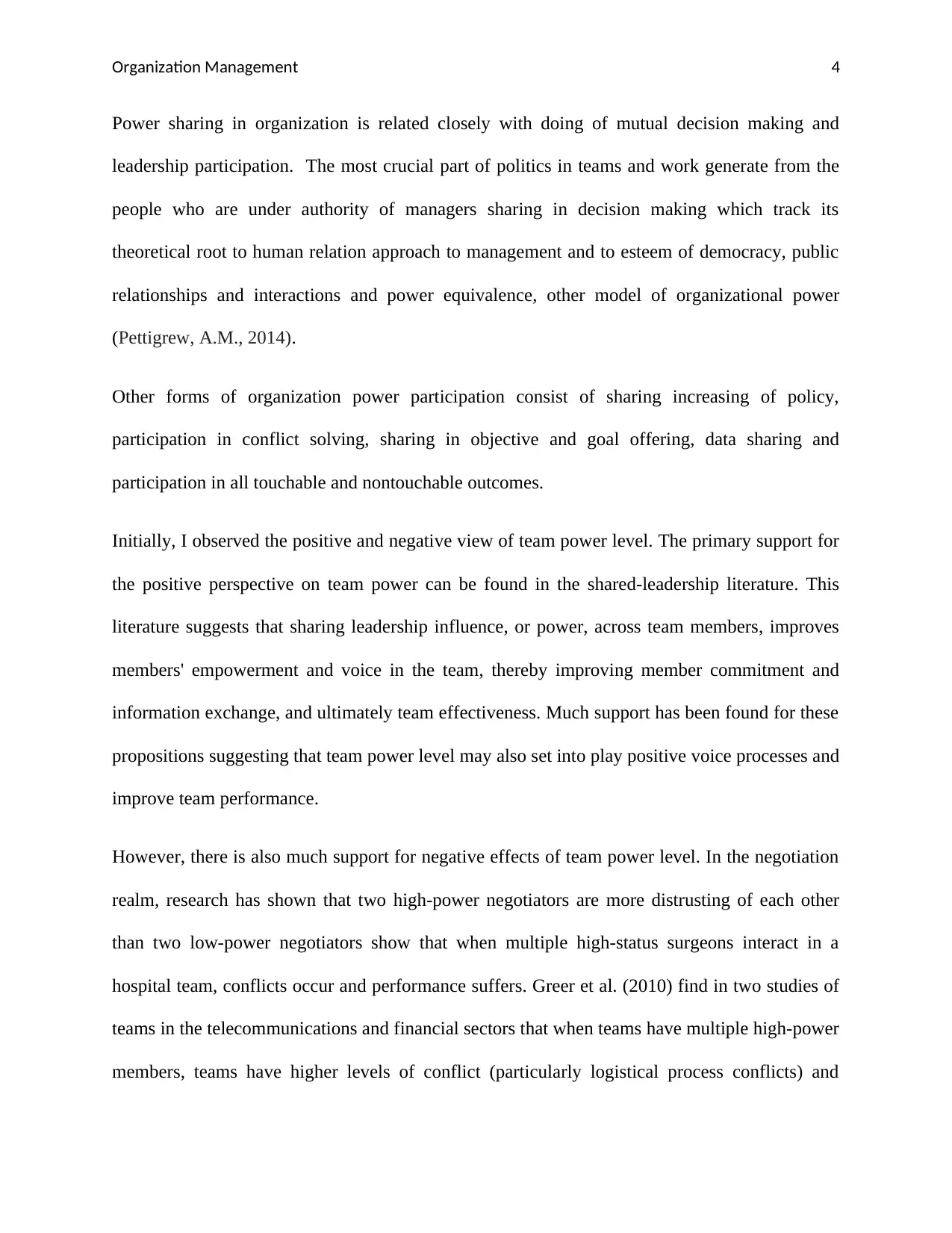
Organization Management 4
Power sharing in organization is related closely with doing of mutual decision making and
leadership participation. The most crucial part of politics in teams and work generate from the
people who are under authority of managers sharing in decision making which track its
theoretical root to human relation approach to management and to esteem of democracy, public
relationships and interactions and power equivalence, other model of organizational power
(Pettigrew, A.M., 2014).
Other forms of organization power participation consist of sharing increasing of policy,
participation in conflict solving, sharing in objective and goal offering, data sharing and
participation in all touchable and nontouchable outcomes.
Initially, I observed the positive and negative view of team power level. The primary support for
the positive perspective on team power can be found in the shared-leadership literature. This
literature suggests that sharing leadership influence, or power, across team members, improves
members' empowerment and voice in the team, thereby improving member commitment and
information exchange, and ultimately team effectiveness. Much support has been found for these
propositions suggesting that team power level may also set into play positive voice processes and
improve team performance.
However, there is also much support for negative effects of team power level. In the negotiation
realm, research has shown that two high-power negotiators are more distrusting of each other
than two low-power negotiators show that when multiple high-status surgeons interact in a
hospital team, conflicts occur and performance suffers. Greer et al. (2010) find in two studies of
teams in the telecommunications and financial sectors that when teams have multiple high-power
members, teams have higher levels of conflict (particularly logistical process conflicts) and
Power sharing in organization is related closely with doing of mutual decision making and
leadership participation. The most crucial part of politics in teams and work generate from the
people who are under authority of managers sharing in decision making which track its
theoretical root to human relation approach to management and to esteem of democracy, public
relationships and interactions and power equivalence, other model of organizational power
(Pettigrew, A.M., 2014).
Other forms of organization power participation consist of sharing increasing of policy,
participation in conflict solving, sharing in objective and goal offering, data sharing and
participation in all touchable and nontouchable outcomes.
Initially, I observed the positive and negative view of team power level. The primary support for
the positive perspective on team power can be found in the shared-leadership literature. This
literature suggests that sharing leadership influence, or power, across team members, improves
members' empowerment and voice in the team, thereby improving member commitment and
information exchange, and ultimately team effectiveness. Much support has been found for these
propositions suggesting that team power level may also set into play positive voice processes and
improve team performance.
However, there is also much support for negative effects of team power level. In the negotiation
realm, research has shown that two high-power negotiators are more distrusting of each other
than two low-power negotiators show that when multiple high-status surgeons interact in a
hospital team, conflicts occur and performance suffers. Greer et al. (2010) find in two studies of
teams in the telecommunications and financial sectors that when teams have multiple high-power
members, teams have higher levels of conflict (particularly logistical process conflicts) and
Paraphrase This Document
Need a fresh take? Get an instant paraphrase of this document with our AI Paraphraser

Organization Management 5
thereby lower levels of team performance.They show that while a certain number of star team
members are good.
Demographic Diversity
The extent to which team processes and outcomes are influenced by the homogeneity or
heterogeneity of team member. Demographic characteristics have also been the focus of
considerable attention, although it is difficult to determine whether team diversity is desirable.
Studies have reported that diversity has positive, negative or even no effects on team
effectiveness (Campion et al., 1993). These mixed findings have led reviewers to draw different
conclusions regarding the effects of diversity: (Bettenhausen 1991) concluded that groups
composed of Work Groups and Teams 13 similar members perform better than those composed
of dissimilar members, whereas Jackson, May, and Whitney (1995) concluded that diversity
tends to have a positive relationship with team effectiveness.
Argote and McGrath (1993) suggested that the effect of diversity on team outcomes is likely to
depend on four factors. First, the effects of diversity probably depend on the nature of the team’s
task. Jackson et al. (1995), for example, concluded that the value of member heterogeneity for
team performance is clearest in the domains of creative and intellective tasks. Second, the effects
of diversity may depend on the particular outcomes studied. Research seems to suggest that
diversity may have a positive effect on performance, but a more negative effect on behavioral
outcomes, such as team member turnover. Third, research has shown that the impact of diversity
may vary across time. Watson, Kumar, and Michaelsen (1993), for example, found that
homogeneous groups displayed better initial performance than heterogeneous groups, but these
effects dissipated across time and heterogeneous groups later performed better than more
thereby lower levels of team performance.They show that while a certain number of star team
members are good.
Demographic Diversity
The extent to which team processes and outcomes are influenced by the homogeneity or
heterogeneity of team member. Demographic characteristics have also been the focus of
considerable attention, although it is difficult to determine whether team diversity is desirable.
Studies have reported that diversity has positive, negative or even no effects on team
effectiveness (Campion et al., 1993). These mixed findings have led reviewers to draw different
conclusions regarding the effects of diversity: (Bettenhausen 1991) concluded that groups
composed of Work Groups and Teams 13 similar members perform better than those composed
of dissimilar members, whereas Jackson, May, and Whitney (1995) concluded that diversity
tends to have a positive relationship with team effectiveness.
Argote and McGrath (1993) suggested that the effect of diversity on team outcomes is likely to
depend on four factors. First, the effects of diversity probably depend on the nature of the team’s
task. Jackson et al. (1995), for example, concluded that the value of member heterogeneity for
team performance is clearest in the domains of creative and intellective tasks. Second, the effects
of diversity may depend on the particular outcomes studied. Research seems to suggest that
diversity may have a positive effect on performance, but a more negative effect on behavioral
outcomes, such as team member turnover. Third, research has shown that the impact of diversity
may vary across time. Watson, Kumar, and Michaelsen (1993), for example, found that
homogeneous groups displayed better initial performance than heterogeneous groups, but these
effects dissipated across time and heterogeneous groups later performed better than more
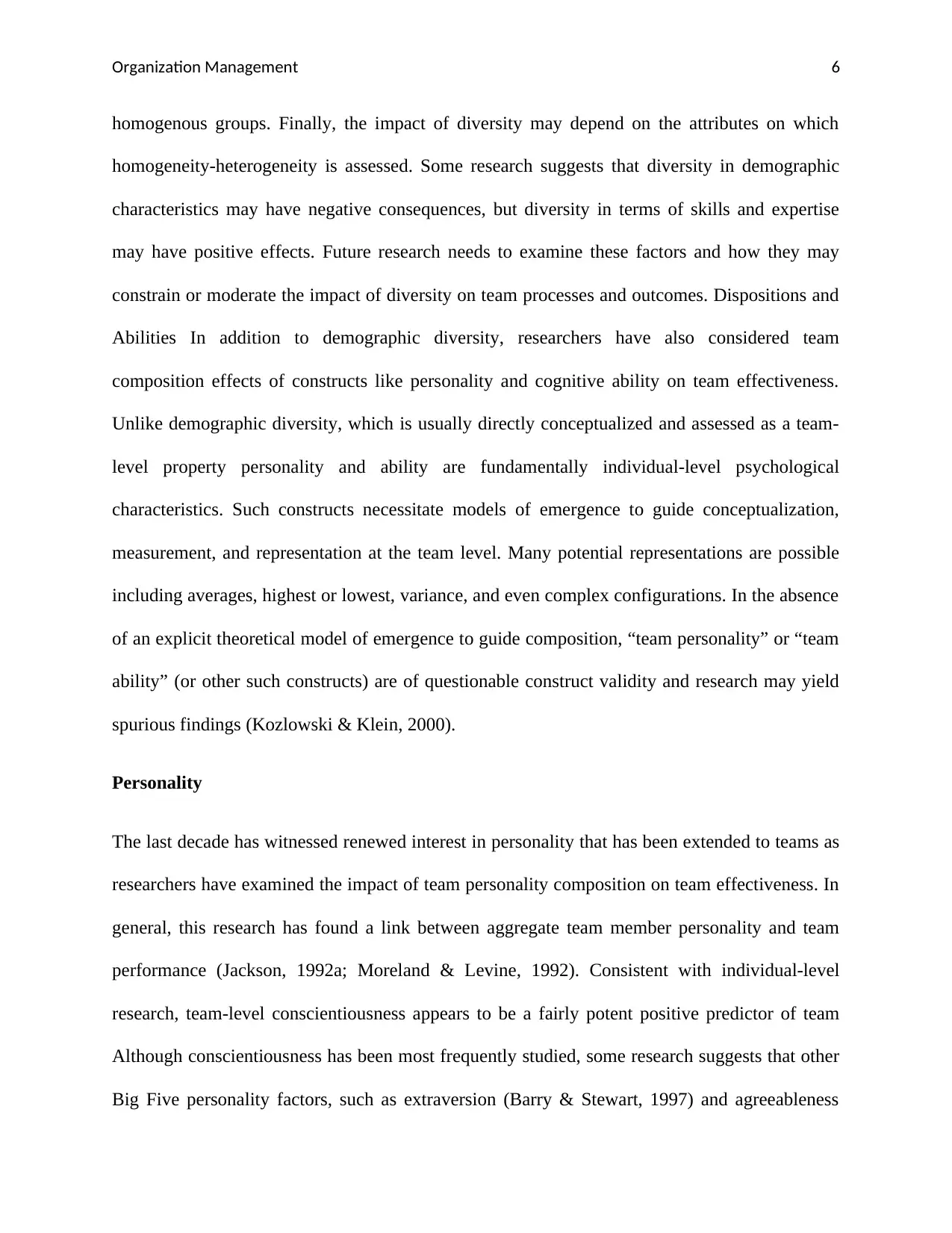
Organization Management 6
homogenous groups. Finally, the impact of diversity may depend on the attributes on which
homogeneity-heterogeneity is assessed. Some research suggests that diversity in demographic
characteristics may have negative consequences, but diversity in terms of skills and expertise
may have positive effects. Future research needs to examine these factors and how they may
constrain or moderate the impact of diversity on team processes and outcomes. Dispositions and
Abilities In addition to demographic diversity, researchers have also considered team
composition effects of constructs like personality and cognitive ability on team effectiveness.
Unlike demographic diversity, which is usually directly conceptualized and assessed as a team-
level property personality and ability are fundamentally individual-level psychological
characteristics. Such constructs necessitate models of emergence to guide conceptualization,
measurement, and representation at the team level. Many potential representations are possible
including averages, highest or lowest, variance, and even complex configurations. In the absence
of an explicit theoretical model of emergence to guide composition, “team personality” or “team
ability” (or other such constructs) are of questionable construct validity and research may yield
spurious findings (Kozlowski & Klein, 2000).
Personality
The last decade has witnessed renewed interest in personality that has been extended to teams as
researchers have examined the impact of team personality composition on team effectiveness. In
general, this research has found a link between aggregate team member personality and team
performance (Jackson, 1992a; Moreland & Levine, 1992). Consistent with individual-level
research, team-level conscientiousness appears to be a fairly potent positive predictor of team
Although conscientiousness has been most frequently studied, some research suggests that other
Big Five personality factors, such as extraversion (Barry & Stewart, 1997) and agreeableness
homogenous groups. Finally, the impact of diversity may depend on the attributes on which
homogeneity-heterogeneity is assessed. Some research suggests that diversity in demographic
characteristics may have negative consequences, but diversity in terms of skills and expertise
may have positive effects. Future research needs to examine these factors and how they may
constrain or moderate the impact of diversity on team processes and outcomes. Dispositions and
Abilities In addition to demographic diversity, researchers have also considered team
composition effects of constructs like personality and cognitive ability on team effectiveness.
Unlike demographic diversity, which is usually directly conceptualized and assessed as a team-
level property personality and ability are fundamentally individual-level psychological
characteristics. Such constructs necessitate models of emergence to guide conceptualization,
measurement, and representation at the team level. Many potential representations are possible
including averages, highest or lowest, variance, and even complex configurations. In the absence
of an explicit theoretical model of emergence to guide composition, “team personality” or “team
ability” (or other such constructs) are of questionable construct validity and research may yield
spurious findings (Kozlowski & Klein, 2000).
Personality
The last decade has witnessed renewed interest in personality that has been extended to teams as
researchers have examined the impact of team personality composition on team effectiveness. In
general, this research has found a link between aggregate team member personality and team
performance (Jackson, 1992a; Moreland & Levine, 1992). Consistent with individual-level
research, team-level conscientiousness appears to be a fairly potent positive predictor of team
Although conscientiousness has been most frequently studied, some research suggests that other
Big Five personality factors, such as extraversion (Barry & Stewart, 1997) and agreeableness
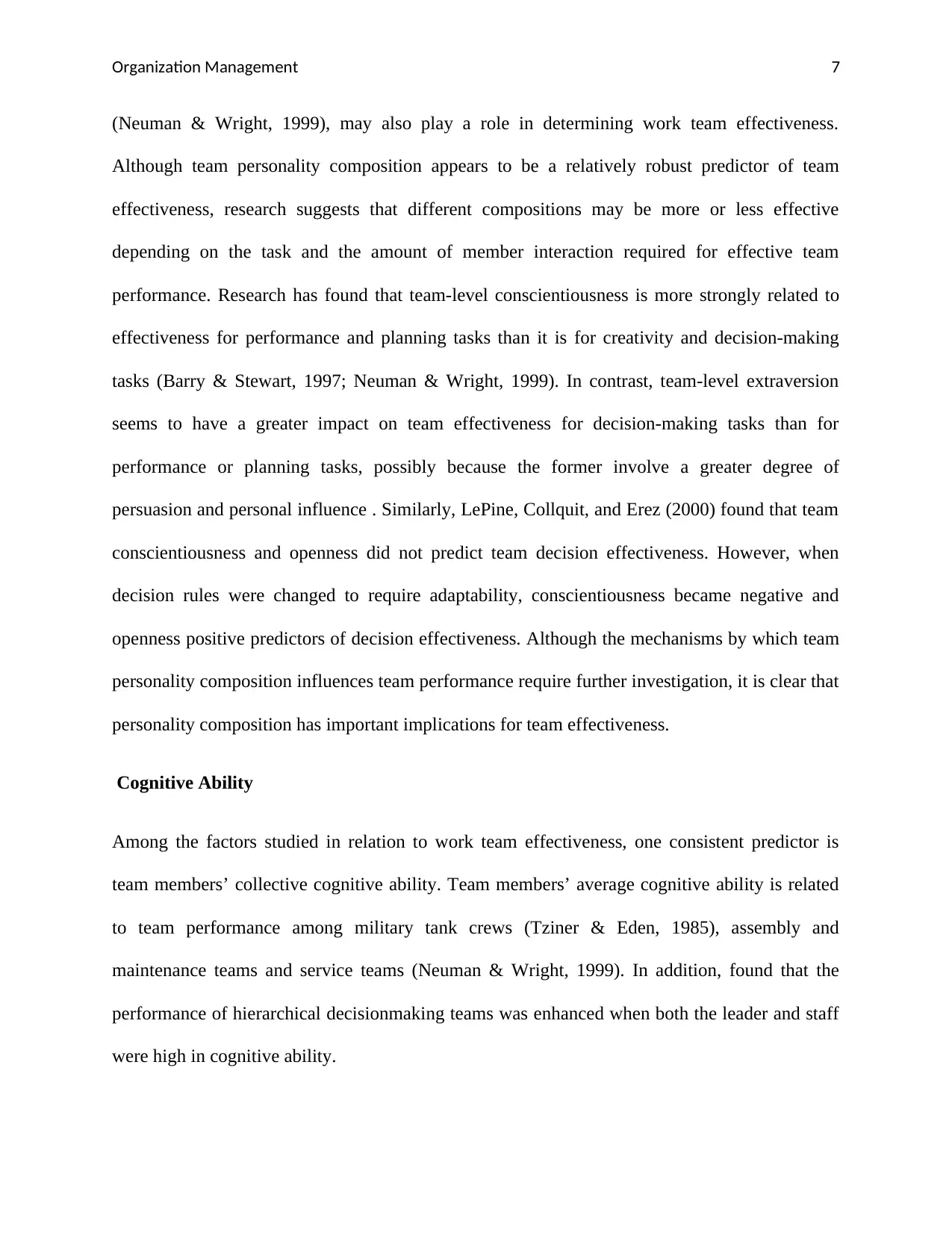
Organization Management 7
(Neuman & Wright, 1999), may also play a role in determining work team effectiveness.
Although team personality composition appears to be a relatively robust predictor of team
effectiveness, research suggests that different compositions may be more or less effective
depending on the task and the amount of member interaction required for effective team
performance. Research has found that team-level conscientiousness is more strongly related to
effectiveness for performance and planning tasks than it is for creativity and decision-making
tasks (Barry & Stewart, 1997; Neuman & Wright, 1999). In contrast, team-level extraversion
seems to have a greater impact on team effectiveness for decision-making tasks than for
performance or planning tasks, possibly because the former involve a greater degree of
persuasion and personal influence . Similarly, LePine, Collquit, and Erez (2000) found that team
conscientiousness and openness did not predict team decision effectiveness. However, when
decision rules were changed to require adaptability, conscientiousness became negative and
openness positive predictors of decision effectiveness. Although the mechanisms by which team
personality composition influences team performance require further investigation, it is clear that
personality composition has important implications for team effectiveness.
Cognitive Ability
Among the factors studied in relation to work team effectiveness, one consistent predictor is
team members’ collective cognitive ability. Team members’ average cognitive ability is related
to team performance among military tank crews (Tziner & Eden, 1985), assembly and
maintenance teams and service teams (Neuman & Wright, 1999). In addition, found that the
performance of hierarchical decisionmaking teams was enhanced when both the leader and staff
were high in cognitive ability.
(Neuman & Wright, 1999), may also play a role in determining work team effectiveness.
Although team personality composition appears to be a relatively robust predictor of team
effectiveness, research suggests that different compositions may be more or less effective
depending on the task and the amount of member interaction required for effective team
performance. Research has found that team-level conscientiousness is more strongly related to
effectiveness for performance and planning tasks than it is for creativity and decision-making
tasks (Barry & Stewart, 1997; Neuman & Wright, 1999). In contrast, team-level extraversion
seems to have a greater impact on team effectiveness for decision-making tasks than for
performance or planning tasks, possibly because the former involve a greater degree of
persuasion and personal influence . Similarly, LePine, Collquit, and Erez (2000) found that team
conscientiousness and openness did not predict team decision effectiveness. However, when
decision rules were changed to require adaptability, conscientiousness became negative and
openness positive predictors of decision effectiveness. Although the mechanisms by which team
personality composition influences team performance require further investigation, it is clear that
personality composition has important implications for team effectiveness.
Cognitive Ability
Among the factors studied in relation to work team effectiveness, one consistent predictor is
team members’ collective cognitive ability. Team members’ average cognitive ability is related
to team performance among military tank crews (Tziner & Eden, 1985), assembly and
maintenance teams and service teams (Neuman & Wright, 1999). In addition, found that the
performance of hierarchical decisionmaking teams was enhanced when both the leader and staff
were high in cognitive ability.
Secure Best Marks with AI Grader
Need help grading? Try our AI Grader for instant feedback on your assignments.
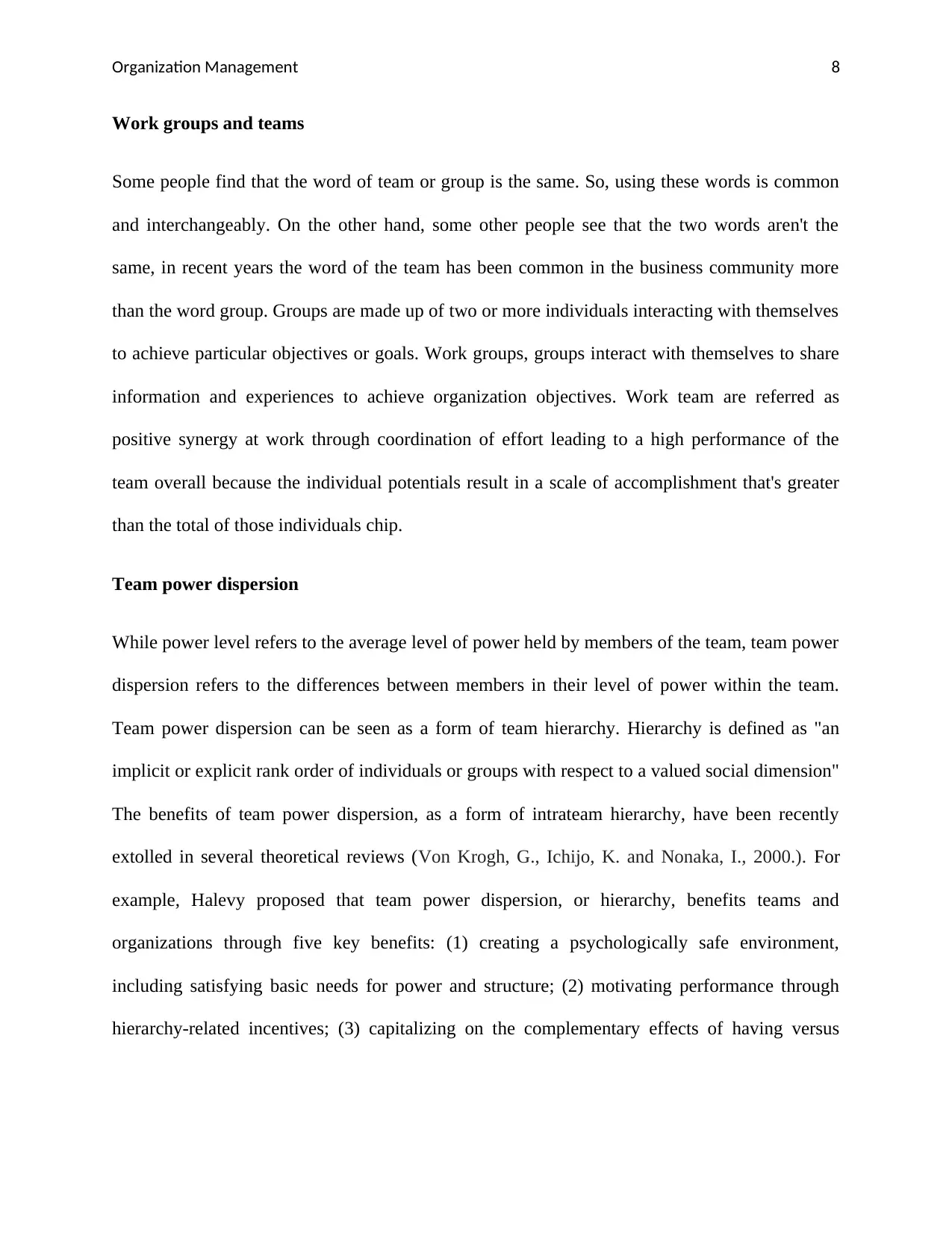
Organization Management 8
Work groups and teams
Some people find that the word of team or group is the same. So, using these words is common
and interchangeably. On the other hand, some other people see that the two words aren't the
same, in recent years the word of the team has been common in the business community more
than the word group. Groups are made up of two or more individuals interacting with themselves
to achieve particular objectives or goals. Work groups, groups interact with themselves to share
information and experiences to achieve organization objectives. Work team are referred as
positive synergy at work through coordination of effort leading to a high performance of the
team overall because the individual potentials result in a scale of accomplishment that's greater
than the total of those individuals chip.
Team power dispersion
While power level refers to the average level of power held by members of the team, team power
dispersion refers to the differences between members in their level of power within the team.
Team power dispersion can be seen as a form of team hierarchy. Hierarchy is defined as "an
implicit or explicit rank order of individuals or groups with respect to a valued social dimension"
The benefits of team power dispersion, as a form of intrateam hierarchy, have been recently
extolled in several theoretical reviews (Von Krogh, G., Ichijo, K. and Nonaka, I., 2000.). For
example, Halevy proposed that team power dispersion, or hierarchy, benefits teams and
organizations through five key benefits: (1) creating a psychologically safe environment,
including satisfying basic needs for power and structure; (2) motivating performance through
hierarchy-related incentives; (3) capitalizing on the complementary effects of having versus
Work groups and teams
Some people find that the word of team or group is the same. So, using these words is common
and interchangeably. On the other hand, some other people see that the two words aren't the
same, in recent years the word of the team has been common in the business community more
than the word group. Groups are made up of two or more individuals interacting with themselves
to achieve particular objectives or goals. Work groups, groups interact with themselves to share
information and experiences to achieve organization objectives. Work team are referred as
positive synergy at work through coordination of effort leading to a high performance of the
team overall because the individual potentials result in a scale of accomplishment that's greater
than the total of those individuals chip.
Team power dispersion
While power level refers to the average level of power held by members of the team, team power
dispersion refers to the differences between members in their level of power within the team.
Team power dispersion can be seen as a form of team hierarchy. Hierarchy is defined as "an
implicit or explicit rank order of individuals or groups with respect to a valued social dimension"
The benefits of team power dispersion, as a form of intrateam hierarchy, have been recently
extolled in several theoretical reviews (Von Krogh, G., Ichijo, K. and Nonaka, I., 2000.). For
example, Halevy proposed that team power dispersion, or hierarchy, benefits teams and
organizations through five key benefits: (1) creating a psychologically safe environment,
including satisfying basic needs for power and structure; (2) motivating performance through
hierarchy-related incentives; (3) capitalizing on the complementary effects of having versus
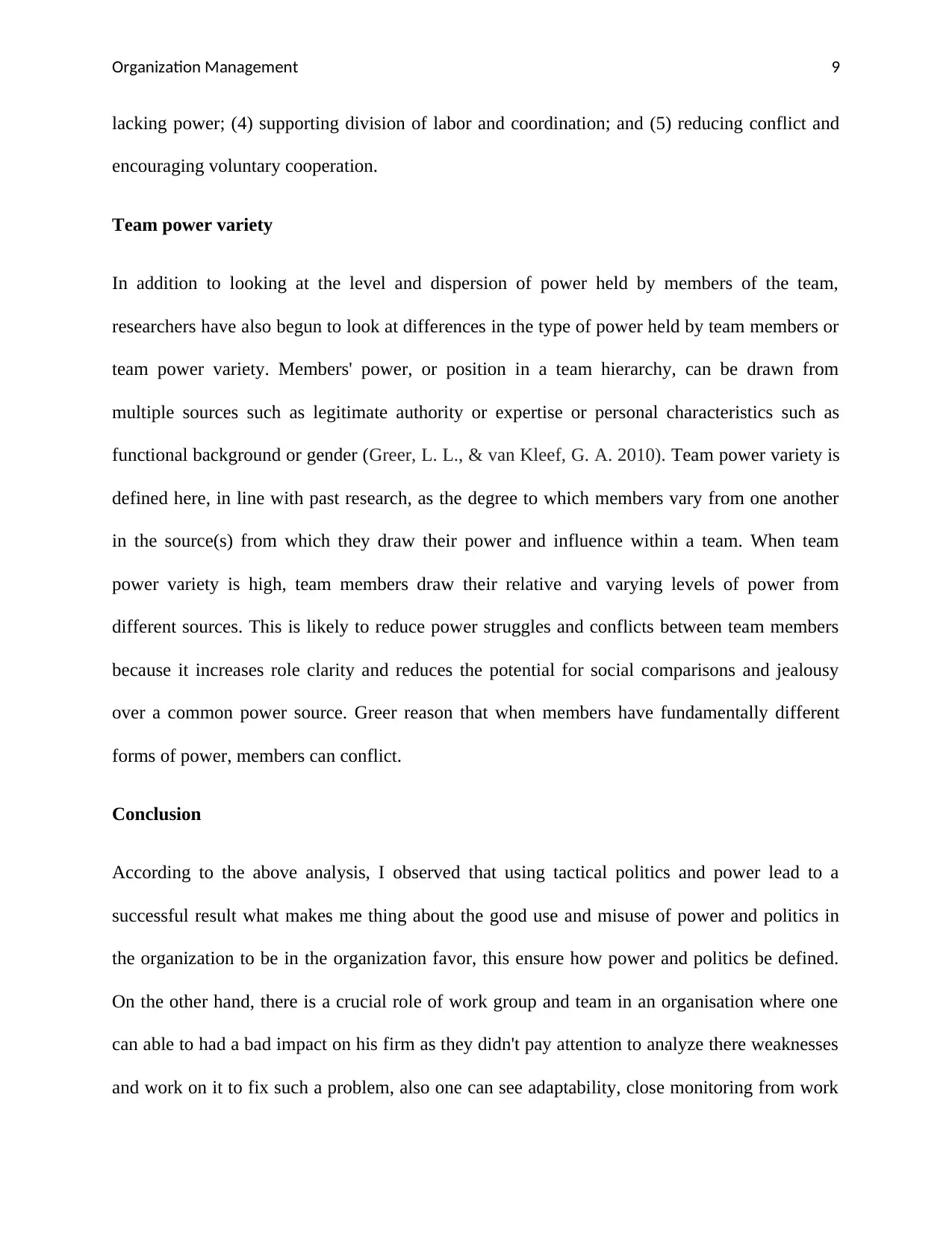
Organization Management 9
lacking power; (4) supporting division of labor and coordination; and (5) reducing conflict and
encouraging voluntary cooperation.
Team power variety
In addition to looking at the level and dispersion of power held by members of the team,
researchers have also begun to look at differences in the type of power held by team members or
team power variety. Members' power, or position in a team hierarchy, can be drawn from
multiple sources such as legitimate authority or expertise or personal characteristics such as
functional background or gender (Greer, L. L., & van Kleef, G. A. 2010). Team power variety is
defined here, in line with past research, as the degree to which members vary from one another
in the source(s) from which they draw their power and influence within a team. When team
power variety is high, team members draw their relative and varying levels of power from
different sources. This is likely to reduce power struggles and conflicts between team members
because it increases role clarity and reduces the potential for social comparisons and jealousy
over a common power source. Greer reason that when members have fundamentally different
forms of power, members can conflict.
Conclusion
According to the above analysis, I observed that using tactical politics and power lead to a
successful result what makes me thing about the good use and misuse of power and politics in
the organization to be in the organization favor, this ensure how power and politics be defined.
On the other hand, there is a crucial role of work group and team in an organisation where one
can able to had a bad impact on his firm as they didn't pay attention to analyze there weaknesses
and work on it to fix such a problem, also one can see adaptability, close monitoring from work
lacking power; (4) supporting division of labor and coordination; and (5) reducing conflict and
encouraging voluntary cooperation.
Team power variety
In addition to looking at the level and dispersion of power held by members of the team,
researchers have also begun to look at differences in the type of power held by team members or
team power variety. Members' power, or position in a team hierarchy, can be drawn from
multiple sources such as legitimate authority or expertise or personal characteristics such as
functional background or gender (Greer, L. L., & van Kleef, G. A. 2010). Team power variety is
defined here, in line with past research, as the degree to which members vary from one another
in the source(s) from which they draw their power and influence within a team. When team
power variety is high, team members draw their relative and varying levels of power from
different sources. This is likely to reduce power struggles and conflicts between team members
because it increases role clarity and reduces the potential for social comparisons and jealousy
over a common power source. Greer reason that when members have fundamentally different
forms of power, members can conflict.
Conclusion
According to the above analysis, I observed that using tactical politics and power lead to a
successful result what makes me thing about the good use and misuse of power and politics in
the organization to be in the organization favor, this ensure how power and politics be defined.
On the other hand, there is a crucial role of work group and team in an organisation where one
can able to had a bad impact on his firm as they didn't pay attention to analyze there weaknesses
and work on it to fix such a problem, also one can see adaptability, close monitoring from work
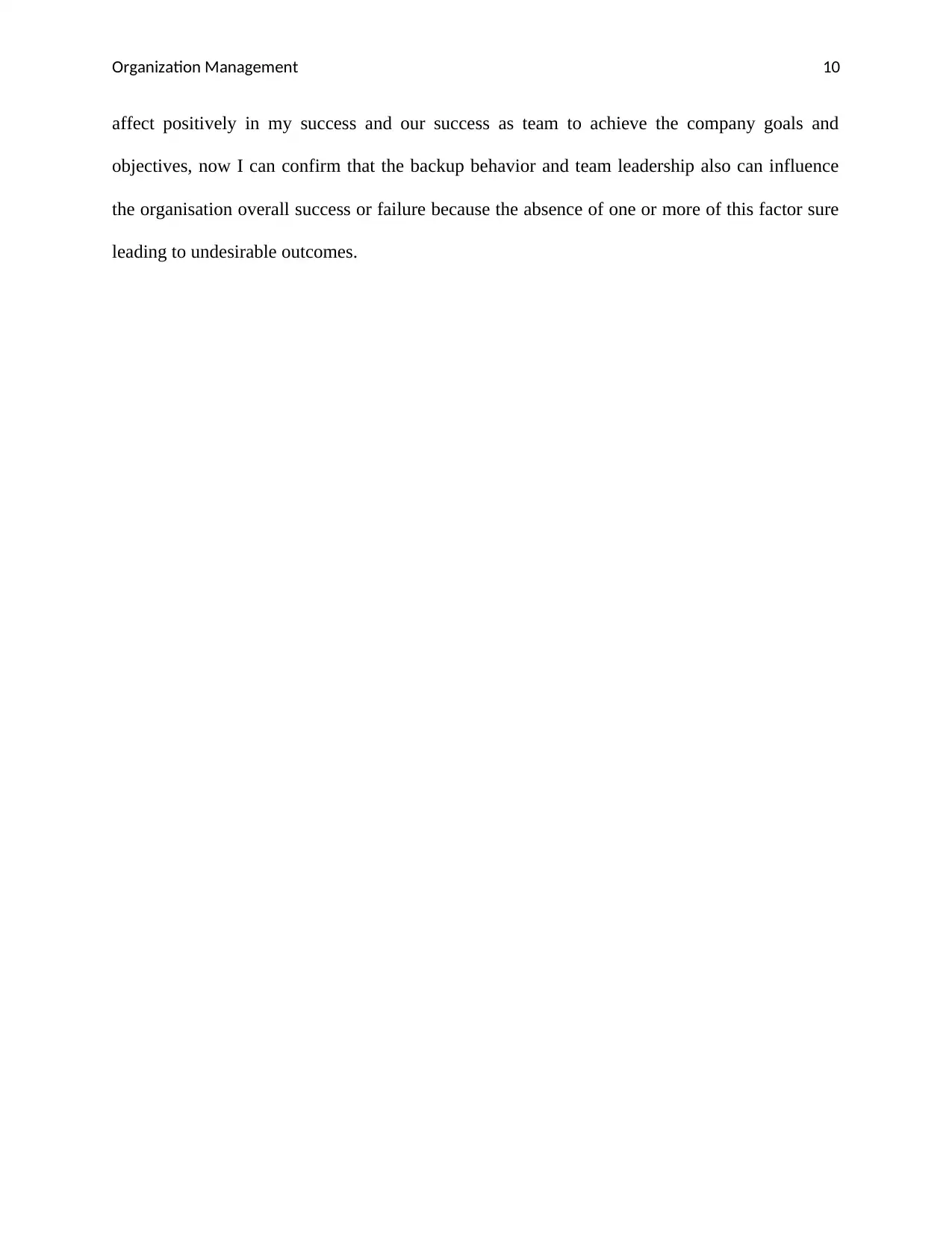
Organization Management 10
affect positively in my success and our success as team to achieve the company goals and
objectives, now I can confirm that the backup behavior and team leadership also can influence
the organisation overall success or failure because the absence of one or more of this factor sure
leading to undesirable outcomes.
affect positively in my success and our success as team to achieve the company goals and
objectives, now I can confirm that the backup behavior and team leadership also can influence
the organisation overall success or failure because the absence of one or more of this factor sure
leading to undesirable outcomes.
Paraphrase This Document
Need a fresh take? Get an instant paraphrase of this document with our AI Paraphraser

Organization Management 11
References
Buchanan, D. and Badham, R., 2008. Power, politics, and organizational change: Winning the
turf game. Sage.
Hekkala, R. and Urquhart, C., 2013. Everyday power struggles: living in an IOIS
project. European Journal of Information Systems, 22(1), pp.76-94.
Greer, L. L., & van Kleef, G. A. (2010). Equality versus differentiation: the effects of power
dispersion on group interaction. Journal of Applied Psychology, 95(6), 1032.
Von Krogh, G., Ichijo, K. and Nonaka, I., 2000. Enabling knowledge creation: How to unlock
the mystery
Barrick, M.R., Stewart, G.L., Neubert, M.J. and Mount, M.K., 1998. Relating member ability
and personality to work-team processes and team effectiveness. Journal of applied
psychology, 83(3), p.377.
Kozlowski, S.W. and Bell, B.S., 2003. Work groups and teams in organizations. Handbook of
psychology.
Mannix, E., & Neale, M. A. (2005). What differences make a difference? The promise and
reality of diverse teams in organizations. Psychological science in the public interest, 6(2), 31-
55.
Pettigrew, A.M., 2014. The politics of organizational decision-making. Routledge.
Bass, B.M. and Avolio, B.J., 1994. Improving organizational effectiveness through
transformational leadership. Sage.
References
Buchanan, D. and Badham, R., 2008. Power, politics, and organizational change: Winning the
turf game. Sage.
Hekkala, R. and Urquhart, C., 2013. Everyday power struggles: living in an IOIS
project. European Journal of Information Systems, 22(1), pp.76-94.
Greer, L. L., & van Kleef, G. A. (2010). Equality versus differentiation: the effects of power
dispersion on group interaction. Journal of Applied Psychology, 95(6), 1032.
Von Krogh, G., Ichijo, K. and Nonaka, I., 2000. Enabling knowledge creation: How to unlock
the mystery
Barrick, M.R., Stewart, G.L., Neubert, M.J. and Mount, M.K., 1998. Relating member ability
and personality to work-team processes and team effectiveness. Journal of applied
psychology, 83(3), p.377.
Kozlowski, S.W. and Bell, B.S., 2003. Work groups and teams in organizations. Handbook of
psychology.
Mannix, E., & Neale, M. A. (2005). What differences make a difference? The promise and
reality of diverse teams in organizations. Psychological science in the public interest, 6(2), 31-
55.
Pettigrew, A.M., 2014. The politics of organizational decision-making. Routledge.
Bass, B.M. and Avolio, B.J., 1994. Improving organizational effectiveness through
transformational leadership. Sage.

Organization Management 12
De Hoogh, A.H. and Den Hartog, D.N., 2008. Ethical and despotic leadership, relationships with
leader's social responsibility, top management team effectiveness and subordinates' optimism: A
multi-method study. The Leadership Quarterly, 19(3), pp.297-311.
De Hoogh, A.H. and Den Hartog, D.N., 2008. Ethical and despotic leadership, relationships with
leader's social responsibility, top management team effectiveness and subordinates' optimism: A
multi-method study. The Leadership Quarterly, 19(3), pp.297-311.
1 out of 12
Related Documents
Your All-in-One AI-Powered Toolkit for Academic Success.
+13062052269
info@desklib.com
Available 24*7 on WhatsApp / Email
![[object Object]](/_next/static/media/star-bottom.7253800d.svg)
Unlock your academic potential
© 2024 | Zucol Services PVT LTD | All rights reserved.





